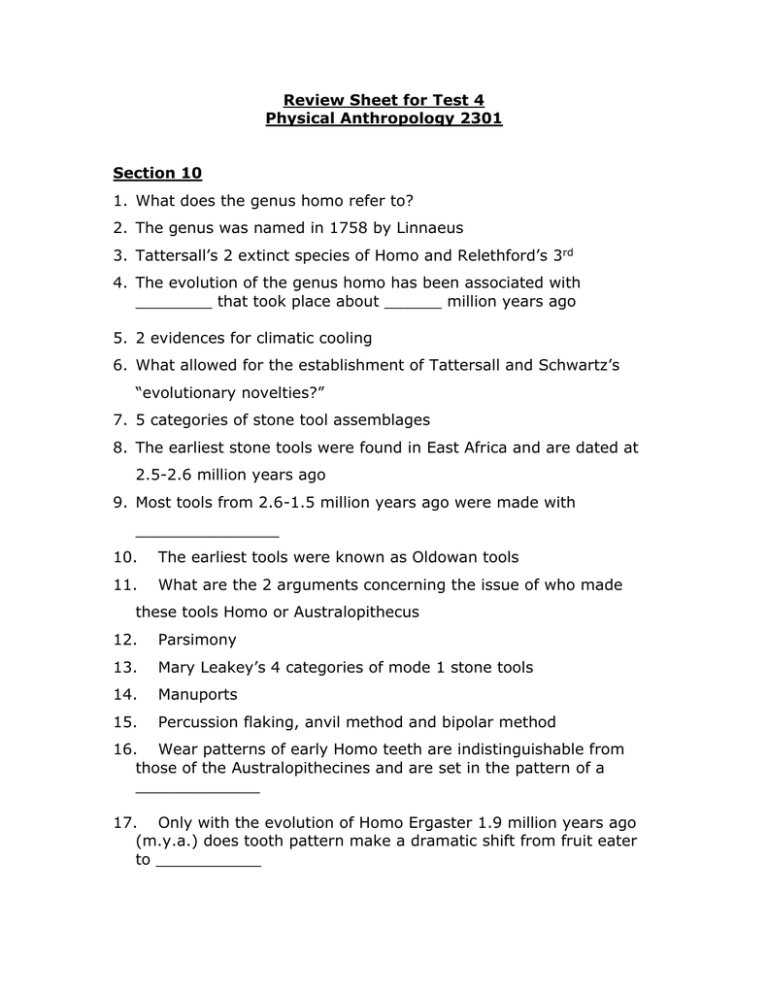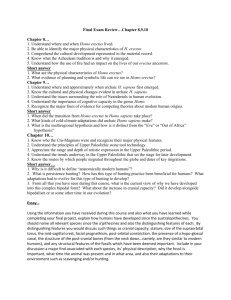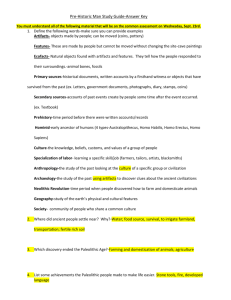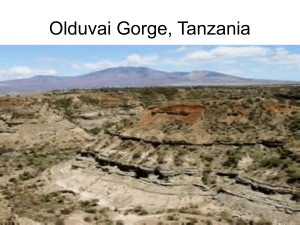HCCAnthPhysicalreview42010.doc
advertisement

Review Sheet for Test 4 Physical Anthropology 2301 Section 10 1. What does the genus homo refer to? 2. The genus was named in 1758 by Linnaeus 3. Tattersall’s 2 extinct species of Homo and Relethford’s 3rd 4. The evolution of the genus homo has been associated with ________ that took place about ______ million years ago 5. 2 evidences for climatic cooling 6. What allowed for the establishment of Tattersall and Schwartz’s “evolutionary novelties?” 7. 5 categories of stone tool assemblages 8. The earliest stone tools were found in East Africa and are dated at 2.5-2.6 million years ago 9. Most tools from 2.6-1.5 million years ago were made with _______________ 10. The earliest tools were known as Oldowan tools 11. What are the 2 arguments concerning the issue of who made these tools Homo or Australopithecus 12. Parsimony 13. Mary Leakey’s 4 categories of mode 1 stone tools 14. Manuports 15. Percussion flaking, anvil method and bipolar method 16. Wear patterns of early Homo teeth are indistinguishable from those of the Australopithecines and are set in the pattern of a _____________ 17. Only with the evolution of Homo Ergaster 1.9 million years ago (m.y.a.) does tooth pattern make a dramatic shift from fruit eater to ___________ 18. The first species of genus Homo is _______ 19. The name Homo (H.) Habilis is from the idea that H. Habilis was the “handyman” or tool maker of the lower Olduvai (Oldowan tools) 20. The main difference between H. Habilis and Australopithecus is the ___________ 21. Cladistics 22. Primitive character, Derived character 23. H. Rudolfensis existed about _____ m.y.a. 24. H. Erectus at the time it was first found (1800s) was seen as the first example of _________ 25. Many European fossils once thought to be H. Erectus are seen as early ___________ 26. H. Erectus cranial capacities and distinctive trait 27. H. Erectus may have been the first hominid to use ________ and ________ effectively 28. The 6 “firsts” of H. Erectus 29. Acheulian tools (associated H. and the difference between this and the Oldowan method) 30. Bifaces 31. The soft hammer technique (and its tradition) 32. The Acheulian tradition was the most widespread cultural tradition 33. Where did archaic humans live? 34. Different stone tool industries co-existed in some areas for a long time—Know Villa’s 3 answers for this diversity 35. Is the Neandertal or human brain size larger? 36. Are Neandertals human ancestors? 37. Mousterian tools (did humans or Neandertals use these tools?) 38. Micromousterian (what it is and where it is found) 39. Mousterian sites are associated with evidence of significant development in __________, __________ and _______ development compared to the earlier Paleolithic stage 40. Chatelperronian (how does it compare to the human Aurignacian period) 41. Another key tool used by the Neandertals was _________ 42. It is noted that many of the groupings concerning H. Habilis and Neandertals are tentative because of the variety of morphologies involved Section 11 1. A problem with assessment of fossil finds in Europe, China, Africa and Java is that these finds display both H. Erectus and H. Sapiens features (referred to as archaic H. Sapiens) 2. Since _______ years ago humans have been anatomically modern in form 3. A general trend that took place were gradual transitions from greater parts H. Erectus to greater parts H. Sapiens 4. The endocranial capacity for archaic H. Sapiens was about 1000 to 1400 ml (the lesser figure was similar to the average for H. Erectus and the larger comparable to the average for a modern human) 5. Specimens of anatomically modern humans from Africa and the Middle East are significantly ______ than those seen elsewhere in the Old World 6. Relethford claims that there is evidence of an early appearance of anatomically modern H. Sapiens in the Middle East from 92,000 years ago. Lewin disagrees and says that these fossils have some archaic human features 7. Provenance 8. It is important to note that it is certain that modern H. Sapiens existed before the youngest known archaic forms 9. Upper Paleolithic, Middle Paleolithic and Lower Paleolithic 10. Variation within and between sites is even greater in the Upper Paleolithic than in earlier cultures 11. The Upper Paleolithic occurred climatically during the maximum ___________ of the last _______ period 12. The Upper Paleolithic is characterized by the development of blade and burin technology 13. Blade, burin 14. The Upper Paleolithic is characterized by the hunting of ________ game 15. Aurignacian 16. Perigordian 17. Gravettes 18. Solutrean 19. Magdalenian 20. The period best known for cave painting was __________ (Altamira, Lascaux) 21. 3 modern hypotheses that deal with the idea of the origins of human beings (include Lewin and H. Erectus idea) 22. Mitochondrial DNA (mtDNA) 23. Using this mtDNA researchers at UC Berkeley argue that the whole world descended from a single village in Africa (other scientists dispute this) 24. The Mitochondrial Eve hypothesis (When and how many people lived with her) 25. Relethford’s regional coalescence model and primary African origin models 26. It is noted that there are other positions in between the single origin model and the multiregional evolutionary models (in addition to the Partial replacement model) 27. Fossil evidence suggests that modern humans may have appeared first in Africa (some consensus on this) 28. Overall, Relethford sees our recent origins as being mostly, but not exclusively out of Africa Section 12 1 Heider’s foraging 2 Up until 10,000 years ago all were foragers (or hunters and gatherers) 3 Wenke’s agriculture 4 One of the most important things about agriculture is not just that it produces great amounts of food, but that it is ________ and ___________ (and its effect on population density and sedentarism) 5 Sedentarism 6 Horticulture (and the relation to agriculture) 7 Paleopathology 8 What can skeletal remains tell us? 9 epidemic, endemic & pandemic 10 Of all the environmental contexts that can affect health, _____ or ____________ may be the most significant 11 Many signs of ill health including the occurrence of _________ may be caused or exacerbated by nutrition in some way 12 Hole and Flannery’s first era (time and population) 13 Extensive land use (and low population densities associated with the first era) 14 Carrying capacity 15 Hole and Flannery’s second era (and time) 16 Shifting cultivation 17 Hole and Flannery’s third stage (and time) 18 Intensive land use (associated with third era) 19 Third stage agriculture led to _______ being formed with tens of thousands of citizens 20 Subsistence farming and related era 21 Life expectancy between A.D. 1 and 1750 22 Life expectancy 23 During the period of A.D. 1-1750 describe population increase 24 The Industrial Revolution and conditions in urbanized areas 25 Disease and pollution in the Industrial era 26 Did mortality rates fall during this era? (also what was the effect on population) 27 What was one of the main reasons for the fall in mortality rates in the second half of the 1700s 28 During the early phase of the Industrial Revolution some areas of Europe experienced a rise in their birthrates (give the 2 possible reasons) 29 In the second half of the 1800s birth rates began to fall (give the 3 possible reasons and 1 reason that was not an influence) 30 Demographic transition theory 31 In the modern era mortality rates have _________ and the major causes of death have also shifted 32 _________ diseases were replaced as the chief causes of death by _______ diseases such as heart disease and cancer 33 epidemiologic transition (and in what countries) 34 emergent (HIV) & re-emergent diseases (Tuberculosis) 35 Birth rates in ____ nations have continued to decline during the 20th century (give the 5 reasons) 36 Population explosion (time and crucial element also)




